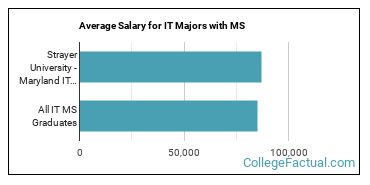 by our College Data Analytics Team
by our College Data Analytics TeamInformation Technology is a major offered under the computer and information sciences program of study at Strayer University - Maryland. Here, you’ll find out more about the major master’s degree program in IT, including such details as the number of graduates, ethnicity of students, related majors and concentrations, and more.
If there’s something special you’re looking for, you can use one of the links below to find it:
In 2019-2020, the average part-time graduate tuition at Strayer University - Maryland was $553 per credit hour for both in-state and out-of-state students. Information about average full-time graduate student tuition and fees is shown in the table below.
| In State | Out of State | |
|---|---|---|
| Tuition | $14,940 | $14,940 |
| Fees | $195 | $195 |
The median early career salary of IT students who receive their master’s degree from Strayer University - Maryland is $87,309 per year. That is 3% higher than the national average of $85,141.

Looking for online learning options? Good news, you can take online classes in the IT master’s degree program at Strayer University - Maryland. To see if the school offers distance learning options in other areas, visit the Strayer University - Maryland Online Learning page.
You may also be interested in one of these majors related to information technology.
| Related Major | Annual Graduates |
|---|---|
| Information Science | 26 |
*The racial-ethnic minorities count is calculated by taking the total number of students and subtracting white students, international students, and students whose race/ethnicity was unknown. This number is then divided by the total number of students at the school to obtain the racial-ethnic minorities percentage.
More about our data sources and methodologies.